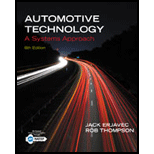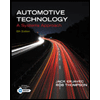
Automotive Technology: A Systems Approach (MindTap Course List)
6th Edition
ISBN: 9781133612315
Author: Jack Erjavec, Rob Thompson
Publisher: Cengage Learning
expand_more
expand_more
format_list_bulleted
Textbook Question
Chapter 25, Problem 4ASRQ
While discussing Hall-effect vehicle speed sensor tests: Technician A says to use an ohmmeter to test the resistance of the coil. Technician B says that the voltage generated by the sensor can be measured by connecting a voltmeter across the sensors terminals. Who is correct?
- Technician A
Expert Solution & Answer
Trending nowThis is a popular solution!

Students have asked these similar questions
Which of the following is not a voltage-generating type sensor?
vehicle speed sensor
OSS
MAP
ISS
Which of the following given sensor is self generating type transducer?
a) Strain gauge
b) Thermocouple
c) Thermistor
d) RTD
Which sensor produces a digital signal? a. Magnetic sensor b. Hall-effect sensor c. Pickup coll d. Bothbandc
Chapter 25 Solutions
Automotive Technology: A Systems Approach (MindTap Course List)
Ch. 25 - OBD II systems use several modes of operation....Ch. 25 - List the four ways that individual components can...Ch. 25 - True or False? A bad ground can cause an increase...Ch. 25 - True or False? An A/F ratio sensor can be tested...Ch. 25 - A typical normal oxygen sensor signal will toggle...Ch. 25 - Prob. 6RQCh. 25 - When an engine is running lean, the voltage signal...Ch. 25 - List six steps involved in performing a visual...Ch. 25 - Many control systems have operating modes that can...Ch. 25 - Which of the following statements about zirconium...
Ch. 25 - Describe the typical procedure for adjusting a TP...Ch. 25 - Why does the rotor for a CKP have one or more...Ch. 25 - A system may fail the catalyst monitor test for...Ch. 25 - A defective LAT sensor or circuit may cause the...Ch. 25 - Which of the following is the least likely cause...Ch. 25 - Technician A says that an oxygen sensor can be a...Ch. 25 - Prob. 2ASRQCh. 25 - While discussing ECT sensor diagnosis: Technician...Ch. 25 - While discussing Hall-effect vehicle speed sensor...Ch. 25 - While discussing TP sensor diagnosis: Technician A...Ch. 25 - While diagnosing the cause of a hard starting...Ch. 25 - While discussing testing OBD II system components:...Ch. 25 - When testing a frequency varying MAF: Technician A...Ch. 25 - Technician A says that a faulty MAF sensor can...Ch. 25 - While discussing the MIL on OBD 11 systems:...
Knowledge Booster
Learn more about
Need a deep-dive on the concept behind this application? Look no further. Learn more about this topic, mechanical-engineering and related others by exploring similar questions and additional content below.Similar questions
- When testing a frequency varying MAF: Technician A says that the frequency should increase with an increase in engine speed. Technician B says that when observed on a lab scope, the signal from the sensor should be a square wave. Who is correct? Technician A Technician B Both A and B Neither A nor Barrow_forwardWhen testing an engine temperature sensor: Technician A uses an ohmmeter to test the thermistor. Technician B says that the thermistor reacts to pressure and applies air pressure to the backside of the sensor. Who is correct? Technician A Technician B Both A and B Neither A nor Barrow_forwardTechnician A says that a faulty TP sensor can cause delayed shifts. Technician B says that delayed shifts can be caused by an open shift solenoid. Who is correct? a. Technician A only b. Technician B only c. Both A and B d. Neither A nor Barrow_forward
- True or False? An A/F ratio sensor can be tested in the same way as an oxygen sensor.arrow_forwardWhich of the following is the most likely cause of a lean condition during acceleration and cruising speeds? a. A defective oxygen sensor b. A defective PCM c. A defective ECT sensor d. A defective MAF sensorarrow_forwardTechnician A says that EMI can affect sensor signals. Technician B says that EMI can cause intermittent driveability problems. Who is correct? Select one: a. Technician A b. Technician B c. Both A and B d. Neither A nor Barrow_forward
- what is meant by sensor bias voltage in automotivearrow_forwardTechnician A says that based on current conditions, a reference voltage sensor modifies a fixed voltage from the computer and sends that voltage back to the computer. Technician B says that most reference voltage sensors are variable resistors or potentiometers. Who is correct? Technician A Technician B Both A and B Neither A nor Barrow_forwardWhile discussing TP sensor diagnosis: Technician A says that a four-wire TP sensor contains an idle switch. Technician B says that in some applications, the TP sensor mounting bolts may be loosened and the TP sensor housing rotated to adjust the voltage signal with the throttle in the idle position. Who is correct? Technician A Technician B Both A and B Neither A nor Barrow_forward
- A digital speedometer constantly reads 0 mph: Technician A says that the problem may be the vehicle speed sensor. Technician B says that the problem may be the throttle position sensor. Who is correct? Technician A Technician B Both A and B Neither A nor Barrow_forwardA transmission has delayed upshifts under all operating conditions: Technician A says that low mainline pressure can cause this. Technician B says that a faulty TFT sensor can cause this. Who is correct? a. Technician A only b. Technician B only c. Both A and B d. Neither A nor Barrow_forwardWhat happens if the TCM determines that the signals from the TFT sensor are incorrect?arrow_forward
arrow_back_ios
SEE MORE QUESTIONS
arrow_forward_ios
Recommended textbooks for you
 Automotive Technology: A Systems Approach (MindTa...Mechanical EngineeringISBN:9781133612315Author:Jack Erjavec, Rob ThompsonPublisher:Cengage Learning
Automotive Technology: A Systems Approach (MindTa...Mechanical EngineeringISBN:9781133612315Author:Jack Erjavec, Rob ThompsonPublisher:Cengage Learning Automotive TechnologyMechanical EngineeringISBN:9781337794213Author:ERJAVEC, Jack.Publisher:Cengage,
Automotive TechnologyMechanical EngineeringISBN:9781337794213Author:ERJAVEC, Jack.Publisher:Cengage,

Automotive Technology: A Systems Approach (MindTa...
Mechanical Engineering
ISBN:9781133612315
Author:Jack Erjavec, Rob Thompson
Publisher:Cengage Learning

Automotive Technology
Mechanical Engineering
ISBN:9781337794213
Author:ERJAVEC, Jack.
Publisher:Cengage,
Mod-01 Lec-16 Basics of Instrumentation; Author: nptelhrd;https://www.youtube.com/watch?v=qbKnW42ZM5c;License: Standard YouTube License, CC-BY